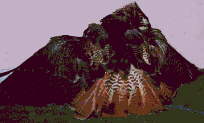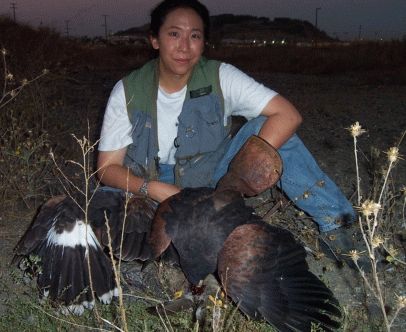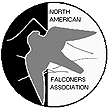Falling Hawks Studio
PO Box 96, St. Matthew's Station
San Mateo, CA 94401
This is the pre-frames version of this web page. It will not be maintained after November 2003. The link to the gallery has been removed because that is a frames-only setup. Links to other frame-based pages in this site now point to the non-frames version. Otherwise, all links should (hopefully) work.
Update History
[Falconer] | [Hoodmaker] [Artistand
Writer] | [What's UP!] | [Falconry]
[Other Interesting Links] |
[Resume] | [The
John Lynch Shrine]
Falconry videos (MPG)
[Old Salty's Advice and Emergency
Help for Hawks]
h o m e o f t
h e a l t . s p o r
t . f a l c o n r y F A Q
the alt.sport.falconry newsgroup
or on
Google
David and I get hitched

Top
Falconry
 Building a relationship with
a hawk is time consuming but very fulfilling. Hawks have their own ways
of thinking, and the way one treats it is completely different from any
ordinary animal pet.
Building a relationship with
a hawk is time consuming but very fulfilling. Hawks have their own ways
of thinking, and the way one treats it is completely different from any
ordinary animal pet.
It is not a sport for everyone: you regularly get muddy and cold and
tired, and there are days when you just don't want to go out even when
all other conditions are perfectly encouraging. Falconry wants those people
who will go out because the bird needs to fly, it wants people who are
stopped only by impending pneumonia, broken legs or death. Falconry is
a lifestyle, an obsession, an addiction. Don't fool yourself into thinking
you can "fit" falconry into an already busy life.
Two hours per day, average, is what falconry requires. The falconer's
life bends to the hawk's needs, not the other way 'round. The foremost
goal should be to make the bird into the best hunting hawk it can be. The
hawk's purpose is not to prove you're cool and unique, that you have a
hawk-brother spirit in your soul, or that you prefer to refer to yourself
as Lord Maulkworth of Faulnwood Castle and you just know no Lord is complete
without a prop faulcon. If you feel that way, hit your browser's "Back"
button a few times and go away. If you want to learn about becoming a falconer,
read on and welcome.
There are goals or stages that the apprentice falconer should attain.
Barring disasters, if you cannot accomplish these things within the space
of 2 years, you should consider another sport. These things are:

 Trapping
your hawk.
Trapping
your hawk.
- Getting it to wear the hood.
- Learning weight control (for the hawk, not
you, although the latter helps)
- Training it to catch game with you.
- Bringing it through the molt.
If you are interested in learning more about falconry, here are several
resources:
- A Rage for Falcons by Stephen
Bodio. It is not a falconry manual, but rather the best book on what it's
like to be a falconer. Reading him can teach the wannabe falconer much,
as well as dispel a lot of tension for the experienced.
- North American Falconry and Hunting
Hawks by Frank Beebe and Harold Webster. The modern falconer's
bible these days. They have an answer for almost any question that you
might ask.
- The
Falconry Information Clearinghouse. Contains lists of vendors
and lots of links to raptor- and falconry-related sites worldwide.
- Your State Department of Fish and Game.
They can direct you to your local falconry club and tell you the legal
requirements to obtain a falconry license. (In California, you must pass
a test, have your mews and equipment inspected by F&G (or your sponsor),
and obtain a sponsor who will teach you the details. The California Hawking
Club's web page is listed below.)
Once you contact your state club, you begin to pursue falconers. Call them
up, tell them you're interested in learning more about the sport, and ask
to follow them around next time they hunt. Observe how they deal with their
birds and ask as many questions as you can. You might want to take a read
of my Old Salty Advice to get a feel for what
goes into training a hawk. Determine for yourself if you have the time
and mindset to be a falconer, but you must be as objective as possible.
If you want it badly enough, take the test, build your mews and choose
who you want as your sponsor. Best of luck to you.
Other Web Falconry Resources:
The alt.sport.falconry newsgroup.
Get your falconry questions answered here.
Yahoo group Huntinghawks, for falconers who actually hunt with their birds. "Are you flyin' or cryin'?" "But lukily I got layed off"
On-Wing, the lady falconers group on Yahoo.
Northwood's, a Falconry
Equipment Supplier
ABE Book Exchange: a cooperative of used booksellers worldwide.
Mexican
Valley Falconers Group
Gerhard Lourens' Falconry webpage
Harrie Knol's Falconry portal
Other interesting links:
Wm. Spear's Gallery
Mr. Spear makes enamel pins of birds, insects, and all sorts of funky things.
Check out the stomachs.
Jean-Luc Ponty - best jazz violinist
on the planet!

Top
Hoodmaking
I've been making hoods for as long as I've been in falconry, mostly
out of necessity. About 3 or 4 years ago I got more serious about it, but
there is so much I don't know that I hate to sell a hood for a hawk I have
not seen. I was using a Dutch-molded Anglo-Indian pattern at that time.
I have modified Nick Fox's pattern into an Anglo-Indian and am presently
using that. I consider my hoods to be "pretty" hoods at a field hood price
of $60. I've
sold about 10 or 15, which is pretty cool.

Top
 What's
UP (in the skies of San Mateo)
What's
UP (in the skies of San Mateo)
Photo: Squeaky left, Polya right, on jackrabbit
October 2003
Squeaky is home! Apparently and unfortunately, he never did manage to make any little Squeakies. The breeder suspects him of being imprinted; I suspect him sterile, but the only rabbit test Squeaky's going to take is the jackrabbit sort.
So now we have a cast of characters. The first few times they flew together was a little hairy. Polya would usually fly at Squeaky 2 or 3 times per hunt, sometimes giving chase. There was one scary situation where Polya held Squeaky by the neck, which was stopped by me clasping Polya's head gently. He jumped back about 2 feet. Squeaks is the prudent sort -- he will give way, avoiding rather than confronting. Which is in some ways unfortunate, because he's the better hunter when it comes to rabbits. If both birds go after quarry, Squeaky may break off the chase if Polya gets too close to him.
Fortunately, this seems to have eased somewhat. I elevated Squeaky's perch by about 1-1/2 inches -- a small difference by measurement, but it seems to have some effect. Of course, I can't say for certain if this is coincidental, but Polya seems to chase Squeaky less than before. There were also some issues of glove possession that seem to have been rectified by making a small right hand perch for Polya. (I found wearing a glove on the right hand made tidbit handling impossible.) So far no catches have been cooperative, but I suspect that one will come fairly soon.
Don't forget I have some "short"
videos. They're big files, so they might take some time to load. I
could also use some advice on compressing them. Enjoy.

Top
Falconry in Ecuador
These few paragraphs come from a chance meeting I had two years ago
with a falconer from Ecuador. It is not meant to be taken as a depiction
of all falconry in that province, but as a record of a style of falconry
which may soon disappear.
Tony is an Ecuadorean Indian who I met by chance in San Juan Bautista,
California. He had been shopping at an American Indian store run by friends
of mine who happened to mention I was coming down to visit and chase some
jacks, and waited patiently two hours for me to show. He was very excited
to learn that falconry was legal in the US and asked many questions about
obtaining a license. Over dinner later, I managed to get a general picture
of how he and his family did their hawking. He had learned falconry from
his grandfather, and was the only person in his generation still doing
it.
Tony's family is the last in his area still practicing subsistence falconry.
My guess is they learned falconry from the Spanish. Their quarry is mostly
rabbits and wild chickens. Not being well acquainted with South American
hawks I was unable to determine the breed of hawk they use, but it seemed
to be in the 30 ounce range and grey to black in color.
The birds are caught as branchers -- "Very easy," Tony said, and mimed
grabbing one. Ecuadorean falconers use longish jesses, and do not use gloves
-- instead they wear a shoulder pad and perch the bird there. Having a
41-oz female redtail at the time, I could appreciate the concept. If the
bird bates, they do not try to hold it until it clambers back onto the
fist as we do, they hold the jesses and let the bird go to ground.
Their idea of hoods is particularly unusual. Instead of the usual pitch-blackness
required by Occidental and Oriental hoods, they allow a hole on each side.
"This way they don't see depth," Tony explained, "they can't tell how far
away a quarry is, so they don't go after it. But they can still see if
something dangerous is coming." I'm not sure what the bird would do if
something dangerous came, but being able to see probably makes them less
shy of the hood.

Top
Art & Writing
I presently have two stories making the rejection rounds among the magazines.
If they get published, I'll slap that info up on this page right away and
start handing out bad advice (heh). I also have three medium-sized novels
cooking.
Working title: Making the New World. It's a rather amusing
future-world tale where everyone on the planet is a pretentious artist.
It has faint echoes of Moorcock's "End of Time" series, but is fortunately
different from anything I've read, or written. Lots of wordplay.
Working title: Quantum Dreams. Half-cooked, half-written.
It covers most everything I have an interest in: falconry, spying, hacking,
computers, abnormal psychology, genetics, the definition of true love,
quantum physics, and what happens to you after you die.
Working title: Helias. Post-post apocalyptic, semi medieval,
city-states, war; a xenophobic exile from another country, a gay scientist,
a lady falconer, and a power-hungry woman on the rise. Arguments, annoyances,
xenophobia, bombs, possible murder, and love. Culture clash: polite hidden
insults versus splattery pigheadedness.
I've alternated between writing and drawing for 16 years. The majority
of my art employs either pencil or ink, and is photorealistic. Yes, I draw
a lot of hawks, but I'm best at people (No, I haven't done John Lynch seriously
yet. Just a sketch or two.) For several years I was totally incapable of
writing a story without seeing it like a movie in my head, so I have 20
sketchbooks filled with comic strips. But I got lazy about backgrounds
(Quantum Dreams has half of it set in a flat anonymous desert and laziness
takes a spot of credit for that.)

Top
Education and Professional Career
BS, Computer Science, Santa Clara University,
1986.
1986 - 1989: Educomp Systems, 1901 Old Middlefield
Way, Mt. View CA 94043.
Network Manager. Installed and configured 3Com, Lantastic, and
Novell servers and workstations delivered as turnkey systems to the K-12
and adult education market. Supported NOS, office automation software,
and troubleshot hardware by phone and in person. Trained summer interns.
1989 - 1996: San Mateo-Foster City Schools,
300 28th Ave., San Mateo CA 94403.
Network Specialist. Installed and maintained 21 Netware 3.12
LANs and WAN via analog routers. In charge of all software and hardware
support for PCs, ethernet LAN and WAN; assisted in hardware and software
support of Macintoshes, LocalTalk and Ethertalk. Advised on acquisition
of new and donated equipment and software. Wrote training materials and
trained end users and assistants. Experience at all OSI levels.
1997: Subcontractor to Greg Mansfield, SASCO
Data Systems, 2288 Charleston Rd., Mt. View CA 94042.
Network Operations Consultant. Conversion and upgrade of local
and wide area networks.
1997 - present: San Mateo-Foster City Schools,
300 28th Ave., San Mateo CA 94403.
Relational Database Developer. Responsible for creating, maintaining
and modifying FoxPro database structure and contents. Database consists
primarily of test scores and reports based on demographics such as ethnicity,
language level, participation in special programs, etc.
Career Highlights
- Upgraded 21 3Com servers to Netware 3.11 and
3.12 for SMFCSD.
- Configured subnets and BOOTP for IP access
of HP 9000 by PCs and Macs across WAN.
- Designed and maintained district WWW page.
- Assisted in writing successful application
for Netday II for Baywood Elementary School. Managed project and participated
in wiring 2 drops per classroom with coax backbone and twisted pair to
desktop.
- Wrote successful Sun Open Gateways Grant,
recieved Sun Netra I5, software, and training. Installation as Web server
is tentatively scheduled for February 1997.
Certifications and Vocational Training
- 3Com 3Wizard Certification (1988)
- Introduction to Telebit Routers (1993)
- Introduction to Cisco Routers (1995)
- Introduction to Sun Solaris 2.x (1996)
- Sun Solaris 2.x Fundamentals (1996)
- Sun Solaris System Administration (1996)

 Building a relationship with
a hawk is time consuming but very fulfilling. Hawks have their own ways
of thinking, and the way one treats it is completely different from any
ordinary animal pet.
Building a relationship with
a hawk is time consuming but very fulfilling. Hawks have their own ways
of thinking, and the way one treats it is completely different from any
ordinary animal pet.




 What's
UP (in the skies of San Mateo)
What's
UP (in the skies of San Mateo)